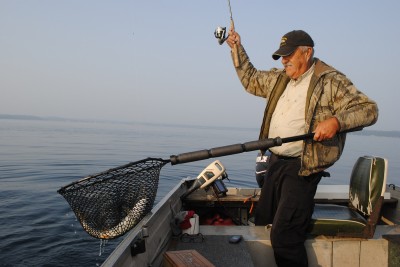The Early Bird Gets the Lake Trout on Grand Traverse Bay
Bob Gwizdz 08.13.14

We were on the water, on the East Arm of Grand Traverse Bay, at first light. Within minutes of settling in over 100 feet of water, Chuck Emmert announced that he’d hooked a fish. I looked at my watch: 6 a.m., on the nose.
Emmert brought the fish up to the side of the boat and our host, Al Scott, slid the landing net under the lake trout and pronounced it a keeper.
About 10 minutes later, I felt something take my spoon, set the hook, and soon reeled in a laker that was smaller than Emmert’s fish, but still better than the minimum 20-inch size limit.
Not too much later, Scott caught a lake trout from 130 feet of water, where we’d drifted, that was a little better than Emmert’s. Three fish within 30 minutes—and all three of us in the plus column—isn’t too shabby, eh?

“Two weeks ago you could catch your limit (which is three apiece, at least 20 inches long, but no more than one 25 inches or greater) in 30 minutes,” Scott said.
A former welder/machinist/truck driver who is now mostly retired, Scott fishes Grand Traverse Bay almost daily from early spring when he returns from wintering in Florida—“There have been times we’ve broken ice to get out there,” he said—until the season closes September 30 up here. He usually catches lake trout, whitefish, and ciscoes.
“Really, everybody wants the whitefish,” Scott said. “But they’re few and far between lately.”
I was happy enough with the lake trout, which were the alpha predators in the Great Lakes before the salmon-stocking program nabbed most of their thunder. Although a few other boats in the area were trolling for them, the bulk of the guys were fishing as we were: jigging with spoons.
“Some guys fish spawn or wigglers or minnows on the bottom, but jigging’s all I ever do,” Scott said. “Usually all you’re doing is making that thing act like a crippled baitfish down there. I jig it very, very lightly, as tight to the bottom as you can get it, and bang, they’ve got it.”
With three fish in the cooler (which is unusual for Scott as more often than not, he just catches and releases the lakers) our fortunes changed. Over the next hour, Emmert missed one, Scott had one nearly to the surface that came unbuttoned, and I never felt a thing.
“They seem to stop biting after an hour or two,” Scott said. “The sun comes up, we’re still marking fish, but they’re not biting.”

It was a gorgeous summer day, unusual in as much as the bay’s surface was as flat as a table top, a phenomenon as rare as honest politicians. We were fishing with Swedish Pimples and Elk Rapid Jigs, which are thick, vaguely S-shaped spoons that really cut a wobbling path on the descent. We were using medium-action rods with spinning reels spooled with Fireline and a length of 10-pound-test fluorocarbon leader attached with a swivel. The Fireline really helped increase our hooking success, Scott said, as there’s too much stretch in monofilament when you’re fishing 100 feet (or more) down.
After a period of inaction, Scott motored away from the pack of boats and began checking some humps that came up within 50 or 60 feet of the surface. And though we didn’t mark any fish there, Scott caught one. But it was the only bite we had shallow (if you can call 60 feet of water shallow) and he soon piloted us back out to 100-plus feet.
“You’ve got to keep looking for them,” Scott said. “Where we fish changes all the time; you’ve got to move around and find where they’re biting. They’re in and out, here one day, gone the next.”
Scott said he’s part of group that shares information so they can keep on top of the fish. The crew fishes both East and West Bays, he said, wherever anyone reports getting into them. At times (usually in May), you can catch them as shallow as 10 or 15 feet, Scott said, but most of the time he’s out there in 100 feet or more.
At 9:30 a.m., having gone more than an hour without a bite, we called it a day. But as Emmert reeled his lure in (a silver/red Swedish Pimple) a lake trout grabbed it (makes you wonder if those fish were distributed in water column, doesn’t it?). It was a keeper.
Lake trout get a bad rap from anglers for a variety of reasons. They are certainly not as spectacular as salmon or steelhead—you won’t see them leaping out of the water, for instance—and they have decidedly less cachet as table fare (except when smoked) than other trout. But Emmert and I split a fillet, lightly dusted in flour with lemon pepper and sautéed in butter, for lunch. It was excellent.
For more information on Michigan fishing go to michigan.org. Click here to purchase a Michigan fishing license online.
This article was produced in partnership with Pure Michigan.

